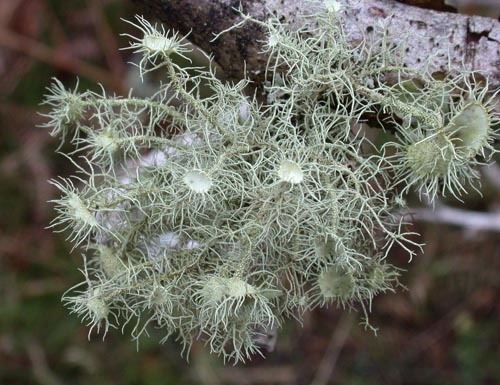Usnea florida
Flowery lichen, witches beard
When well-developed this is one of the most conspicuous and beautiful of all lichens. It forms rounded, upright, yellow-green shrub-like colonies on the twigs and smaller branches of trees and shrubs and occasionally on the timber of fences and gates. Usually abundantly fertile, its fruits are flat circular discs (apothecia) up to a centimetre or more in diameter surrounded by a fringe of finger-like lobes resembling an image of the sun or a flower. The base of the lichen is brown to black and the stems and branches when examined with a x10 hand lens are covered in warts and lack any short fragile clusters of branches (isidia) or eruptions of tiny patches of flour-like granules (soredia).

Photo: Alan Hale
These latter structures are found in the rather similar Usnea subfloridana that can also have flower-like reproductive structure, though these seldom reach 0.5cm in diameter. Occasionally specimens will be encountered that cannot be confidently named and recent work on gene sequences suggests U. florida and U. subfloridana are very closely related. There are a number of other Usnea species that superficially resemble this species though none develop such large fruiting discs whilst remaining erect and shrub-like.
 |
 |
| U. florida - main stem with low warty bumps, but soredia and isidia completely absent | U. subfloridana - stem and branches carry small soralia, but the granules (soredia) produced by them soon give rise to clustters of short isidia |
Drawings: Alan Orange
Usnea species have been used medicinally for over a thousand years. Most species contain usnic acid amongst other substances which is recognised as a potent antibiotic and antifungal agent, effective against all gram-positive and tuberculosis bacterial species. It has been used to treat surface wounds when sterile gauze and modern antibiotics were unavailable. Native Americans employed it as a compress applied to severe battle wounds to prevent infection and gangrene. It is also said to be edible and to contain a high level of vitamin C. In modern American herbal medicine, Usnea is primarily used in lung and upper respiratory tract infections, and urinary tract infections. There are no human clinical trials to either support or refute either practice, although in vitro research does strongly support Usnea's antimicrobial properties.
- Read more about Usnea florida
- Log in to post comments
